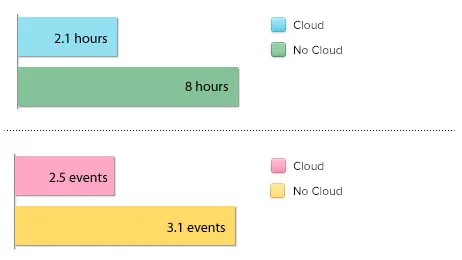Average Downtime of Cloud Users vs. Non-Cloud Users

Cloud computing seems to be the buzzword of the decade and more businesses are making the switch every day. While harnessing the power of cloud computing to streamline IT processes can make daily computing much easier, it's not something to rush into. Before you make the switch, it's important to ask this question: "Am I ready?" Stratosphere Networks is here to help by weighing the pros and cons below.
Advantages:- Easy implementation. Cloud hosting allows business to retain the same applications and business processes without having to deal with the backend technicalities. Readily manageable by the Internet, a cloud infrastructure can be accessed by enterprises easily and quickly.
- Accessibility. Access your data anywhere, anytime. An Internet cloud infrastructure maximizes enterprise productivity and efficiency by ensuring your application is always accessible. This allows for easy collaboration and sharing among users in multiple locations.
- No hardware required. Since everything will be hosted in the cloud, a physical storage center is no longer needed. However, a backup could be worth looking into in the event of a disaster that could leave your company's productivity stagnant.
- Cost per head. Overhead technology costs are kept at a minimum with cloud hosting services, enabling businesses to use the extra time and resources for improving the company infrastructure.
- Flexibility for growth. The cloud is easily scalable so companies can add or subtract resources based on their needs. As companies grow, their system will grow with them.
- Efficient recovery. Cloud computing delivers faster and more accurate retrievals of applications and data. With less downtime, it is the most efficient recovery plan.
- No longer in control. When moving services to the cloud, you are handing over your data and information. For companies who have an in-house IT staff, they will be unable to handle issues on their own. However, Stratosphere Networks has a 24/7 live help desk that can rectify any problems immediately.
- May not get all the features. Not all cloud services are the same. Some cloud providers tend to offer limited versions and enable the most popular features only, so you may not receive every feature or customization you want. Before signing up, make sure you know what your cloud service provider offers.
- Doesn't mean you should do away with servers. You may have fewer servers to handle which means less for your IT staff to handle, but that doesn't mean you can let go of all your servers and staff. While it may seem costly to have data centers and a cloud infrastructure, redundancy is key for backup and recovery.
- No Redundancy. A cloud server is not redundant nor is it backed up. As technology may fail here and there, avoid getting burned by purchasing a redundancy plan. Although it is an extra cost, in most cases it will be well worth it.
- Bandwidth issues. For ideal performance, clients have to plan accordingly and not pack large amounts of servers and storage devices into a small set of data centers.
- Since my data is not in my control, can I trust that my data will be secure?
- Is it truly accessible anytime? What happens if the cloud fails?
- Will my provider ensure I am getting top performance of my cloud services? Can I test this to make sure I am getting my money's worth?
- Will I be able to move applications and data around seamlessly? And is it accessible from anywhere? 5. How much could it lower costs? Is having additional in-house software worth it for backup purposes?
Read about the basics of cloud technology on our infographic "Reach New Heights with the Cloud."
And if you want to learn more about the three types of cloud options (public, private & hybrid), check out our infographic "Cloud Wars."
Next Steps
For help answering any of your questions about switching to the cloud, contact a Stratosphere Networks representative at 877-599-3999 or sales@stratospherenetworks.com.
Contact StratosphereFind out how Stratosphere helped a client improve cybersecurity posture.
Read Case Study